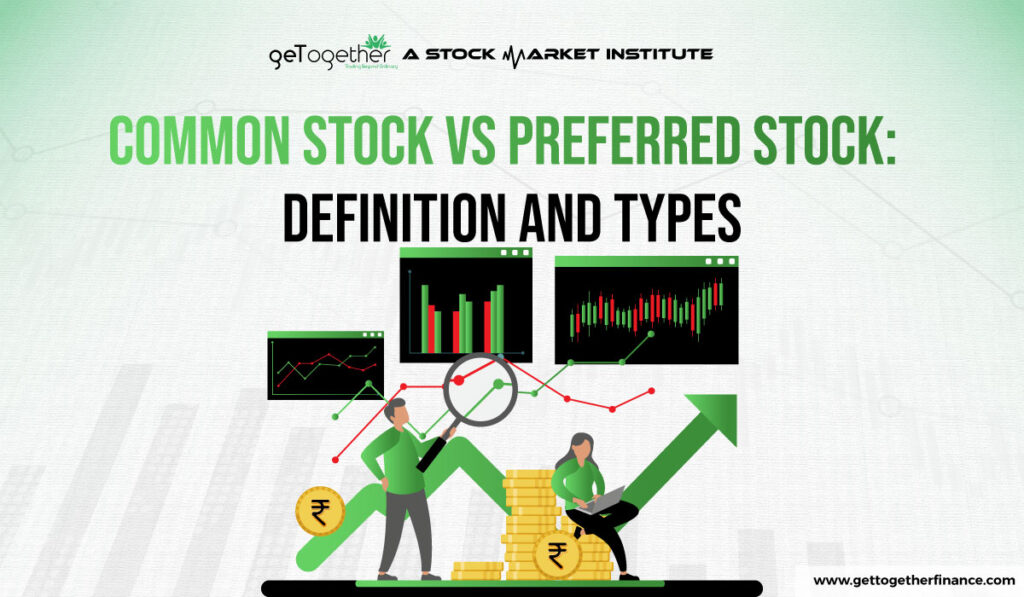Common Stock vs Preferred Stock: Definition and Types


Introduction
The stock market is much more than just buying and selling stocks. There are so many different types of stocks that can fulfill your unique investment goals. One of the most common types of stocks that put investors in dilemma is common stocks and preferred stocks. Though both provide ownership of the company to the shareholders or investors, both have distinct characteristics and give different types of rights to the shareholder.
Common stocks and preferred stocks give ownership in exchange for capital, but the rights and benefits that both shareholders get are different. From a broader perspective, investors who want to play ultra-safe in the equity market go with preferred shares whereas the ones who are willing to take risks with the growth of the company go with equity shares. Let’s dive deep into the world of both sharing and understanding their work thoroughly.
What are Common Stocks?

The most basic type of equity ownership offered by the company is in the form of common stocks. These are the types of stocks that are available easily for us to trade on NSE, BSE, and other stock exchanges via brokers. The ones we buy after researching about the company and face all the ups and downs of it throughout the investment journey.
Common shares give the voting rights to the shareholders and the right to have dividends as per the announcement. However the common shareholders are not obligated to receive dividends in every circumstance if the company has not made profits in a financial year, then it can skip dividend or bonus issues, and common shareholders are obliged to ask for it. But, they are always given a first hand as a voter in the board meetings of the company they choose to invest in.
Investors generally have one voting right per meeting to elect the best board member who’ll be responsible for taking care of the management and project executions that in turn will give benefits to the company and its shareholders. Common stockholders have the right to exercise control over the policy of the company’s corporate policies and management issues.
Also Read: Navratna Stocks
Types of Common Stock
Some major types of common stocks that can help you build good wealth are:
- Growth Stocks: These are companies that are in the process of rapid expansion, which easily catches the attention of investors with good fundamentals as well as technicals.
- Value Stocks: These are the undervalued stocks with a lower P/E ratio compared to the market average and stock performance. Investors see these stocks as an excellent investment opportunity as they might grow with market structure.
- Large-Cap Stocks: These are the companies with a market cap of more than Rs 20,000 crores. Investors see these companies as a safe investment for the long run.
- Mid-Cap Stocks: These companies are valued between Rs 5000 crores – Rs 20,000 crores. Investors see these companies as a diversifying investment option that can ease their portfolio structure as they have good growth opportunities in the long run.
- Small-Cap Stocks: These are companies whose value is lower than Rs 5000 cr at the time but have excellent business structures combined with good technical charts. This promising analysis keeps investors hooked on small-cap stocks to get good returns over a short period of time.
What are Preferred Stocks?

Preferred stocks are somewhat similar to bonds with distinct characteristics of common stocks. Preferred stocks and common stocks differ in terms of voting rights and dividend issues. Similar to bondholders, preferred shareholders are obliged to receive regular dividend payments that are pre-determined by the company. This dividend is received irrespective of what type of performance the company has shown and the profits it has made.
The intrinsic value of preferred shares is determined by the interest rates. This makes them a top investment option for the ones who are looking to invest for a handful of regular income without any hassle.
Also, the time when the company is selling its assets and dividing its equity or declaring bankruptcy, preferred stocks have the first claim over their assets to get their principal amount back.
Types of Preferred Stocks
Here are the major types of preferred shares that you can buy directly from stock exchanges:
- Convertible: These are preferred stocks that are 100% convertible for a certain period into common stocks.
- Non-Convertible: These are not convertible under any circumstance.
- Partly Convertible: In these, a fraction of your shares are convertible after a certain date.
- Cumulative: These preferred stocks pay fixed dividends to regular investors usually at quarterly intervals based on the par value of the share.
- Callable: Gives the firm that issued the shares the opportunity to redeem or “call” the stock at a predetermined price before the dividend payment period ends.
- Perpetual: Pays a fixed dividend to the investor for the duration of the issuing company’s existence, with no expiration date.
Difference Between Common Stock and Preferred Stock

Some of the major differences between common stock and preferred stocks are:
| Feature | Common Stocks | Preferred Stocks |
| Ownership | Represents ownership in a company | Represents ownership but with priority over common stock |
| Voting Rights | Typically grants voting rights on corporate matters | Generally does not grant voting rights |
| Dividends | Dividends are not fixed and not guaranteed | Dividends are fixed and typically higher than common stock dividends |
| Dividend Priority | Paid after preferred stock dividends | Paid before common stock dividends |
| Claim on Assets | Last claim on assets in the event of liquidation | Higher claim on assets than common stock, after debt holders |
| Risk Level | Higher risk due to lower claims on assets and variable dividends | Lower risk due to fixed dividends and higher claims on assets |
| Price Volatility | Typically more volatile | Generally less volatile than common stock |
| Growth Potential | Higher potential for capital appreciation | Lower potential for capital appreciation |
| Convertibility | Usually non-convertible | Can be convertible into common stock at certain conditions |
These differences help investors decide which type of stock aligns better with their investment goals and risk tolerance.
Where Should I Invest, Common Stock or Preferred Stock

Common stocks and preferred stocks are two different yet similar types of securities that can be distinguished based on the investor’s goal. If you are a trader and want to buy and sell stocks in a short span of time then you must go with common stocks. Whereas, if you want to go with a type of investment that gives regular returns to a certain type without any risk, you can go for preferred stocks.
Common stocks and preferred stocks can also go hand in hand. If you want to have a diversified portfolio then go for a combination of both. Buy common shares where you think the returns are gonna be in your account in the short-term. And subsequently, buy preferred stocks of well-established companies with good interest rates. This way, you get to be the bull rally that might come and also have stable returns from another stock.
Conclusion
Your investment in common stocks and preferred stocks, it is determined by your financial goals, risk tolerance, and investment plan. Common stocks are appropriate for those who want to participate in a company’s growth and are willing to take increased risk and volatility in exchange for the possibility of bigger rewards. They provide voting rights and the opportunity of capital appreciation. Preferred stocks, on the other hand, offer greater stability through fixed dividends and higher claims on assets, making them ideal for investors wanting consistent income while minimizing risk. Understanding the distinct qualities and benefits of each allows you to make better selections and build a diversified portfolio that blends growth potential with income stability.
Frequently Asked Questions
What are the main differences between common stocks and preferred stocks?
Common stocks provide ownership in a corporation with voting rights and the possibility for capital appreciation, but they are riskier and pay fluctuating dividends. Preferred stocks reflect ownership but do not normally provide voting rights. They pay stable, greater dividends and have a stronger claim on assets in the event of liquidation, making them less risky.
Which type of stock is better for long-term growth?
Common stocks are generally preferable for long-term growth because they have a bigger possibility for capital gains. Investors can benefit from the company’s long-term growth and profitability.
Are dividends guaranteed with preferred stocks?
Yes, preferred stock dividends are normally fixed and guaranteed, and they are paid before common stock dividends. This makes preferred stocks an appealing choice for investors looking for consistent income.
Can preferred stocks be converted into common stocks?
Some preferred stocks are convertible, which means they can be changed into a specified amount of common stock after a set length of time or under certain conditions. There are also non-convertible and partially convertible preferred stocks.
Should I include both common stocks and preferred stocks in my portfolio?
Including both common stocks and preferred stocks in your portfolio can help you achieve a mix of growth potential and income stability. Common stocks can bring financial appreciation, whereas preferred stocks can provide consistent income while lowering total portfolio risk. This diversification method might help you reach a variety of financial goals.



 Instagram
Instagram 
